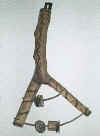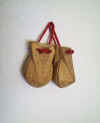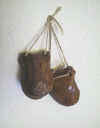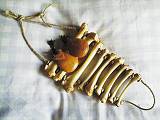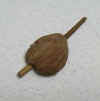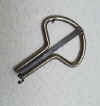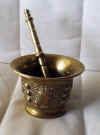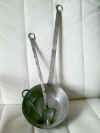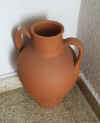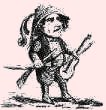|
Click on the images to enlarge them
| Castañuelas: Possibly one of the most extended and well-known instruments in the peninsula. It sound takes place when two wooden concave and hollowed pieces tied with a rope to the hands collide. They are played with both hands. There are many sizes of them, from the "pitos" of León and Zamora, with the size of the thumb, until the big "chácaras" of La Gomera, in Canarias. In the picture, two models from the north of Cáceres, the one of above is from Plasencia, very figured and the one of below is from Montehermoso, more rustic, carried out to knife tip . | |
|
|
| Arrabel: Also called "ginebra" or "huesera", in the case of being formed by bones. Made with a group of canes, sticks or bones tied to each other. It is played getting tied up them to the neck and rubbing them with a castanet. Their use is common in the whole Iberian peninsula. In Colmenar de Oreja (Madrid) it is accompanied of the "zambomba" to sing folk songs in the streets . | |
|
|
| Birimbao: Also called "guimbarda", it is an instrument used in the rest of Europe and other areas of the world, and in the Iberian peninsula it was very normal to find him in Galicia. The sound takes place putting the instrument in contact with the teeth and the metallic reed generates the sound with its vibration pulsing it. Then, the vibrations can be modulated in the buccal cavity. It can give a bass pedal note and others ones that go conforming the melody . | |
|
|
| Sartén: The same as the previous one, sometimes rubbing the handle with a key, other times hitting the bottom with a tablespoon and in other cases hitting it with a tablespoon and a thimble each one in one hand -as Peñaparda's style, in the county of Salamanca - this instrument is used in home meetings to the fire of the kitchen. Of this way, we can speak of a rubbed idiophone or a hit one, according to the use of it. I can't say that there are a certain area of development, because it is for sure that when having it so by hand it has been used in all the peninsula. | |
|
|
| IDIOPHONES |
|---|
